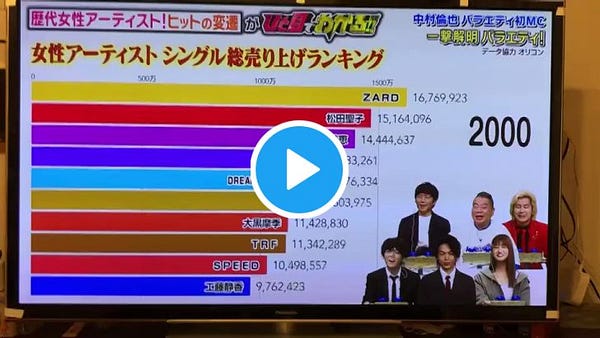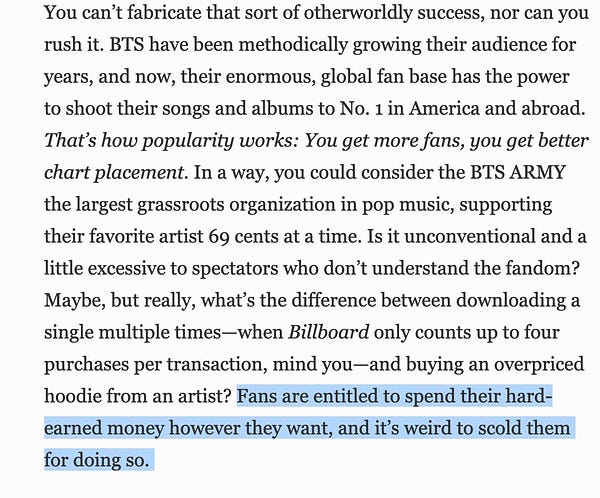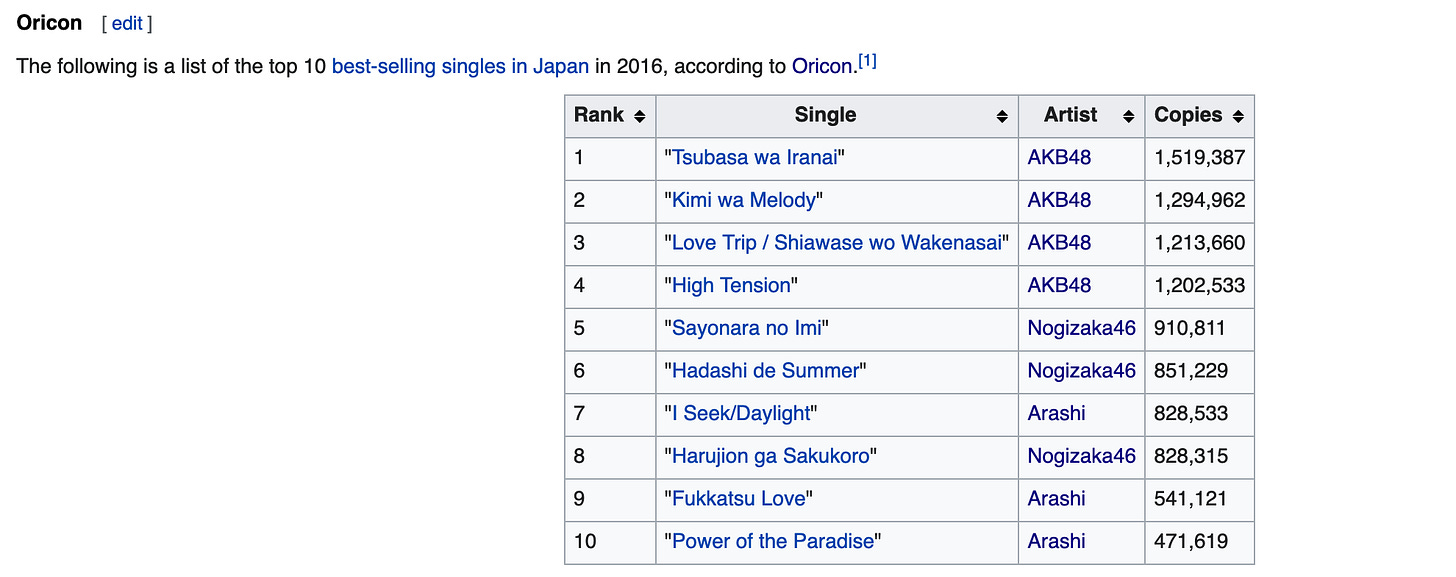Billboard — A Crate Of DJ Khaled Energy Drinks Abandoned On A Mountain
Last week, Stereogum ran an opinion piece titled “BTS And Their Fan Army Are Rendering The Pop Charts Useless.” The gist of it — the K-pop group topped the Billboard Top 100 with new single “Butter,” but said song isn’t really the most popular tune in America right now. It benefits from hyper-mobilized fan support…which the author Tom Breihan emphasizes has been utilized by other number-one acts via a lot of well-trodden topics from recent years, ranging from merch bundles to special releases. The issue was that marquee acts distort what is still seen as the benchmark chart for popularity.
As always happens when someone pegs anything around BTS, things fell apart. Aggrieved supporters let their frustrations be known, while Forbes ran a sorta-kinda counter article that touched on the valid issues warping the charts sprinkled with message-board-worthy defense of the most popular Asian music group ever. The central point of both pieces blurred away in favor of familiar arguments.
Forget anything about BTS, though, because these pieces and other recent chat around the Billboard Charts signaled the latest evolution of the AKB48-ification of American music.
Pictured: Box of multiple copies of the same AKB48 single on the street near my house circa 2018. “Please take for free.” I took one.
For the unfamiliar: AKB48 formed in 2005 and quickly morphed into a J-pop juggernaut, standing as the best-selling female act in Japanese music history and boasting over 40 number-one singles on the country’s Oricon Charts, historically the most trusted system in the nation. They did that, though, with a very well-documented approach to sales, focusing on getting fans to express their support through multiple purchases, distributed across multiple versions of the same song that all counted towards one unified release. Many came with physical presents, tickets to handshake events or…smartest of all…ballots for the yearly AKB48 election, eventually dubbed “a festival of democracy” where more ballots = more votes for your fave. Stories about boxes of discarded CDs found in nature became an annual media tradition, and a symbol of what the group represented — they’re popular, but not that popular.
In the early 2010s, AKB48 stood as the example of how Japanese music was out of step with the rest of the world. Turns out that — like “sexless Japan” and “overwork” trends before them — this exoticized quirk was actually a preview of where everything was going.
Music exists in a fandom economy now. Monocultural hits still emerge but a lot more of what does well on charts is the result of artists hyper-focusing on their most passionate fans. See merch bundles, energy drinks, albums-as-concert-tickets, different versions of the same release and so much more.1 With AKB48, this system revolved around CD sales…as the Oricon Chart only counted physical sales until a few years ago. It’s even messier in the digital-first West, where bad actors (purchased streams, bots, insert scary dystopian music tech here) collide with murkier approaches (coordinated streaming campaigns). It’s not inherently bad, but does change what charts are suppossed to measure in an environment where music is often just part of a larger package and/or experience.
This isn’t a revelation —when Taylor Swift is putting out four different “deluxe” versions of her album, each with different “diaries” for fans to gobble up, it has become the norm. What’s new with last week’s BTS brouhaha is that people are more openly wrangling with what it means for the charts feeling like they are falling short of capturing what people listen to. The Stereogum piece explores specific methods for playing the chart game, but also tiptoes into a far more nebulous space by mentioning the idea that “Butter” doesn’t feel like the biggest song in the States, pointing to radio and streaming charts. That ties to bigger conversations, like The New York Times looking at how different charts had different number ones, or turning to the conspiratorial like this Dirt post about fake Spotify streams and the new Olivia Rodrigo album.
And they are the exact same conversations writers and cultural observers in Japan had, like, seven years ago. They proliferated on Japanese message boards and eventually in publications, and crossed over to English-language writing on Japanese music too, with W. David Marx offering a stellar summation of it as part of his “The Great Shift In Japanese Pop Culture” series from 2011.2 Writers are still revisiting this period of AKB48 dominance, with a Yahoo! Japan piece from earlier this year turning back to a period when “it was difficult to see what was really a hit, due to people no longer relying only on CDs to listen to music.” Even the big counter argument rolled out by fans of acts engaging in this — fans are buying the music of the artists they love! — was explored on Japanese TV, within the context of the AKB48 election.
From Daisuke Kikuchi and I’s celebration of the AKB48 senbatsu system from 2012.
Living Outside Charts
American pop finds itself stuck in a 2chan thread from 2015, and this current confusion about what exactly the Billboard chart measures in 2021 — the actual experience of listening to a song? strength of individual fandoms? sales of music despite the whole streaming and YouTube thing? — probably won’t be solved anytime soon.
I have no insight into how it could go, but what I can share is what happened in Japan after people got sick of seeing year-end Oricon rankings that looked like this.
AKB48’s sales elevated a popular group into a phenomenon, but one which, outside of two songs, never translated into the sort of omnipresence of a SMAP, Namie Amuro or Southern All-Stars — think playing out of street speakers, soundtracking school lunches or playing inside a Daiso. Eventually, the public got sick of seeing them dominate Oricon, which had failed to reflect pretty much anything else happening in Japanese music during this stretch, primarily by sticking with only CD sales despite a growing shift away from plastic being the go-to way of listening to music. Even publications like Nikkei were questioning their “true popularity” in 2014.
In 2016, a shift happened. That’s the year Spotify debuted in the Japanese market…but that was nothing compared to the sudden blossoming of YouTube into the main destination for listeners to find new music. That’s the year of “Perfect Human,” “PPAP” and “Koi,” numbers existing far from Oricon’s top spot (the last one debuted at two, but never climbed up on physical alone) but defining J-pop over that 12 month span. They were engaging and invited viewers to get in on the fun — plus, Pikotaro was sort of ahead of the curve of where “dance challenges” were going.3
If you want a specific sea change moment, it comes a year later, when singer-songwriter Aimyon releases her major-label debut album Excitement Of Youth. It did nothing on Oricon — a peak of 26 in 2017 — but killed on the main subscription streaming services, now becoming entrenched with a younger generation of listeners. I talked with someone at Warner Music Japan — Aimyon’s label — in 2018, and they pointed to Excitement Of Youth’s strong performance on these platforms — and how it just never left the top five of any of them for like two years — as their personal awakening about the future being digital. I feel like at that instance the industry itself was realizing…hey, who cares about Oricon?
Oricon probably realized that too, because they debuted a “digital chart” in 2018, albeit one still separated from their primary rankings. It was too late — besides Aimyon’s album, singles like “Uchiage Hanabi” were becoming year-defining hits despite barely cracking the Oricon top ten. DA PUMP’s 2018 song “U.S.A.” — a mind-melting combination of Eurobeat, the shoot dance and a mid-life crisis — turned into the year’s anthem thanks to YouTube, then-ascendant TikTok and a lot of meme-ry. It peaked at 7 on Oricon. Today, some of the biggest breakthrough acts in Japan don’t even put out physical releases, unthinkable a decade ago.
The “Lost Deacde Of J-pop” article from above argues that, as Oricon’s influence diminished, the (twist!) Billboard Japan charts stepped in with metrics that actually counted a variety of ways one could experience music, rather than just the plunking down of money for CDs. That’s fair — Billboard Japan has always done better — and even seemingly inspired Oricon to finally change, rolling out a combined ranking a couple years back.
Yet I’d argue most people just…don’t need charts anymore. To get an accurate view of what’s happening in Japan (or…anywhere???) today requires looking at data spread across platforms — YouTube is different than TikTok which is different than Spotify which is somehow a lot different than LINE Music, and don’t forget how TV still has heavy sway here, so a theme song to a popular drama might be a whole other angle to look at — to divine anything. The traditional charts themselves are just another reference point, and they aren’t the end of discussions, offering value but not being this monolithic force. Fans have known this for years, and now those in Japanese music have come around to it as well.
Virtual YouTuber Gawr Gura sings “chart-topping” song “Castaways” by The Backyardigans
I don’t live in America nor do I pretend to have much information on what’s happening in music there, so I have no idea how the charts will shake themselves out, if at all. Maybe it embraces the attention it receives and mutates into something better viewed as a fandom chart — what Oricon was, and kind of still is (they continue to post a “physical only” chart, after all) — or tinkers the formula some more, giving them time before savvy fans figure out how to engage with that too.
Or maybe they follow the path Japan drifted towards, where Billboard and Oricon Combined are best seen as a trend guide to a fragmented music industry, where looking at where, how and why a song breaks through is more important than arguing about its overall popularity. Bragging rights don’t mean as much…but that’s not all that bad, and feels pretty chill.
Written by Patrick St. Michel (patrickstmichel@gmail.com)
Twitter — @mbmelodies
Follow the Best of 2021 Spotify Playlist Here!
I’ll keep the obnoxious “I told you so” stuff down here but…when I’m right, I’m right, and I could see this happening back in 2013 when “deluxe editions” offered extra sales juice for pop artists while people like Lady Gaga resorted to extreme AKB-like tactics to move up the charts.
One detail from this essay that never clicked with me until re-reading it now — “AKB48 have also been extremely popular on YouTube, which skews towards a tech-savvy male audience in Japan.” While mixed at going abroad, AKB48 were early on using the internet to develop a fandom that would then push them higher up the mainstream.
Though, let’s add a necessary ironic twist to this conversation; despite leaning on CDs to play the chart game, AKB48 also somehow managed to be among the first pop groups in the country to create a YouTube dance craze with 2013’s “Koi Suru Fortune Cookie,” complete with folks all over the world sharing their own versions of it. This from a video being “look, we are actually popular with people!”…and willing it to be. No pop group from the 21st century is more interesting.












The most annoying thing about this discourse re: the American charts is that it's apparently fine to be a professional music writer and talk about BTS and the charts and not talk about how they couldn't get radio play for years because US radio wouldn't play songs in Korean and how fans reacted to that. A Korean group who mostly sings in Korean's success on the Billboard charts is not exactly the same as that of an American group who sings in English, and it's not exactly the same as a Japanese group singing in Japanese charting in Japan. It feels so crazy that major publications can talk about the success of BTS and not talk about this.